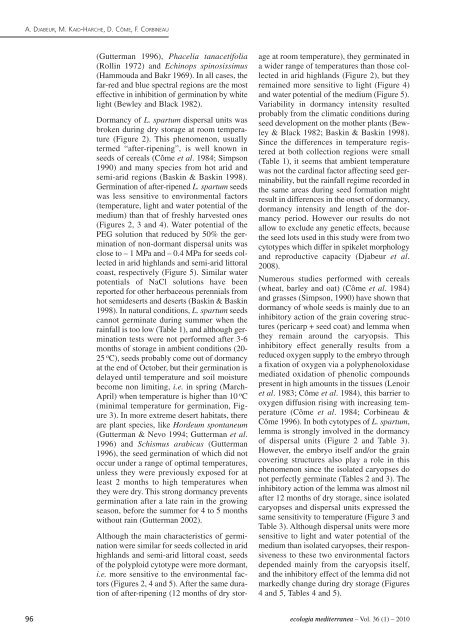Revue internationale d'écologie méditerranéenne International ...
Revue internationale d'écologie méditerranéenne International ...
Revue internationale d'écologie méditerranéenne International ...
Create successful ePaper yourself
Turn your PDF publications into a flip-book with our unique Google optimized e-Paper software.
A. DJABEUR, M. KAID-HARCHE, D. CÔME, F. CORBINEAU<br />
96<br />
(Gutterman 1996), Phacelia tanacetifolia<br />
(Rollin 1972) and Echinops spinosissimus<br />
(Hammouda and Bakr 1969). In all cases, the<br />
far-red and blue spectral regions are the most<br />
effective in inhibition of germination by white<br />
light (Bewley and Black 1982).<br />
Dormancy of L. spartum dispersal units was<br />
broken during dry storage at room temperature<br />
(Figure 2). This phenomenon, usually<br />
termed “after-ripening”, is well known in<br />
seeds of cereals (Côme et al. 1984; Simpson<br />
1990) and many species from hot arid and<br />
semi-arid regions (Baskin & Baskin 1998).<br />
Germination of after-ripened L. spartum seeds<br />
was less sensitive to environmental factors<br />
(temperature, light and water potential of the<br />
medium) than that of freshly harvested ones<br />
(Figures 2, 3 and 4). Water potential of the<br />
PEG solution that reduced by 50% the germination<br />
of non-dormant dispersal units was<br />
close to – 1 MPa and – 0.4 MPa for seeds collected<br />
in arid highlands and semi-arid littoral<br />
coast, respectively (Figure 5). Similar water<br />
potentials of NaCl solutions have been<br />
reported for other herbaceous perennials from<br />
hot semideserts and deserts (Baskin & Baskin<br />
1998). In natural conditions, L. spartum seeds<br />
cannot germinate during summer when the<br />
rainfall is too low (Table 1), and although germination<br />
tests were not performed after 3-6<br />
months of storage in ambient conditions (20-<br />
25 o C), seeds probably come out of dormancy<br />
at the end of October, but their germination is<br />
delayed until temperature and soil moisture<br />
become non limiting, i.e. in spring (March-<br />
April) when temperature is higher than 10 o C<br />
(minimal temperature for germination, Figure<br />
3). In more extreme desert habitats, there<br />
are plant species, like Hordeum spontaneum<br />
(Gutterman & Nevo 1994; Gutterman et al.<br />
1996) and Schismus arabicus (Gutterman<br />
1996), the seed germination of which did not<br />
occur under a range of optimal temperatures,<br />
unless they were previously exposed for at<br />
least 2 months to high temperatures when<br />
they were dry. This strong dormancy prevents<br />
germination after a late rain in the growing<br />
season, before the summer for 4 to 5 months<br />
without rain (Gutterman 2002).<br />
Although the main characteristics of germination<br />
were similar for seeds collected in arid<br />
highlands and semi-arid littoral coast, seeds<br />
of the polyploid cytotype were more dormant,<br />
i.e. more sensitive to the environmental factors<br />
(Figures 2, 4 and 5). After the same duration<br />
of after-ripening (12 months of dry stor-<br />
age at room temperature), they germinated in<br />
a wider range of temperatures than those collected<br />
in arid highlands (Figure 2), but they<br />
remained more sensitive to light (Figure 4)<br />
and water potential of the medium (Figure 5).<br />
Variability in dormancy intensity resulted<br />
probably from the climatic conditions during<br />
seed development on the mother plants (Bewley<br />
& Black 1982; Baskin & Baskin 1998).<br />
Since the differences in temperature registered<br />
at both collection regions were small<br />
(Table 1), it seems that ambient temperature<br />
was not the cardinal factor affecting seed germinability,<br />
but the rainfall regime recorded in<br />
the same areas during seed formation might<br />
result in differences in the onset of dormancy,<br />
dormancy intensity and length of the dormancy<br />
period. However our results do not<br />
allow to exclude any genetic effects, because<br />
the seed lots used in this study were from two<br />
cytotypes which differ in spikelet morphology<br />
and reproductive capacity (Djabeur et al.<br />
2008).<br />
Numerous studies performed with cereals<br />
(wheat, barley and oat) (Côme et al. 1984)<br />
and grasses (Simpson, 1990) have shown that<br />
dormancy of whole seeds is mainly due to an<br />
inhibitory action of the grain covering structures<br />
(pericarp + seed coat) and lemma when<br />
they remain around the caryopsis. This<br />
inhibitory effect generally results from a<br />
reduced oxygen supply to the embryo through<br />
a fixation of oxygen via a polyphenoloxidase<br />
mediated oxidation of phenolic compounds<br />
present in high amounts in the tissues (Lenoir<br />
et al. 1983; Côme et al. 1984), this barrier to<br />
oxygen diffusion rising with increasing temperature<br />
(Côme et al. 1984; Corbineau &<br />
Côme 1996). In both cytotypes of L. spartum,<br />
lemma is strongly involved in the dormancy<br />
of dispersal units (Figure 2 and Table 3).<br />
However, the embryo itself and/or the grain<br />
covering structures also play a role in this<br />
phenomenon since the isolated caryopses do<br />
not perfectly germinate (Tables 2 and 3). The<br />
inhibitory action of the lemma was almost nil<br />
after 12 months of dry storage, since isolated<br />
caryopses and dispersal units expressed the<br />
same sensitivity to temperature (Figure 3 and<br />
Table 3). Although dispersal units were more<br />
sensitive to light and water potential of the<br />
medium than isolated caryopses, their responsiveness<br />
to these two environmental factors<br />
depended mainly from the caryopsis itself,<br />
and the inhibitory effect of the lemma did not<br />
markedly change during dry storage (Figures<br />
4 and 5, Tables 4 and 5).<br />
ecologia mediterranea – Vol. 36 (1) – 2010
















